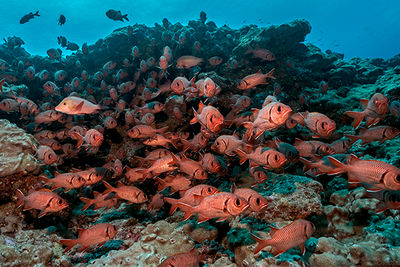French Polynesia is a watery wonderland for divers. Boasting some exceptional big fish diving (think wild dolphins, schools of over 200 reef sharks, manta cleaning stations, fish spawning, big schools of barracuda and jack) in warm, tropical waters, there is so much to explore above and below the waves. On a recent research trip to this South Pacific paradise, our diving expert Louisa Fisher had the chance to delve into the Tuamotus Islands and discover some seriously dreamy dive spots. Read on to find out about her trip…

The Location: the Tuamotus Islands
Almost 300 miles from Papa'ete - the main island of remote French Polynesia - lies the Tuamotus Islands. Comprised of 77 mostly low-lying coralline islands and atolls, it forms the biggest chain of atolls in the world. Much of the diving takes place in the atoll passes, and although each atoll has only one or two main passes to dive, the variation in currents means you can dive the same pass multiple times and have a completely different experience.

Bottlenose Dolphins in Rangiroa
First up is Rangiroa, the largest atoll in the Tuamotus whose main island is so narrow you can see the ocean either side of the road as you head to your hotel or pension (Tahitian family lodgings). The diving here mainly takes place in the Tiputa Pass which is often touted as one of the best dive sites in the world - and it's easy to see why. On almost every dive I was graced with visits from common bottlenose dolphins, which, when in a playful mood, came into the dive group and demanded attention from all the divers. Add to this schooling grey reef sharks, schools of eagle rays and great hammerheads (November to February) as well as white tip, black tip, tiger, silky and silvertip sharks. I was also here during the months where paddle snapper spawn (October and November) so the reef was home to thousands and thousands of snapper.

Mantas in Tikehau
Neighbouring Rangiroa, is the small and serene Tikehau (meaning 'Peaceful Landing'). Comprised of lots of tiny motus - reef islets formed by broken coral and sand - the atoll is adorned with wonderful white and pink sand beaches and an unimaginably beautiful lagoon which the famous French explorer Jacques Cousteau claimed had the highest concentration of fish life of any lagoon in French Polynesia. I spent hours watching the reef from my overwater bungalow at the beautiful Pearl Beach Resort - you didn't even need to get in the water to know how good it was going to be! The two diving highlights in this atoll include a manta cleaning station beside an old derelict pearl farm and Tuheiava Pass, which has spectacular fish life.

The Jewel in the Crown: Fakarava
Travel 200 miles from Tikehau and you'll reach Fakarava, a UNESCO Biosphere Reserve that has been protected for more than 40 years. Fakarava means 'beautiful' and the name is certainly fitting as this atoll it is right up there with the most beautiful places I have ever travelled to, both above and below the waves, and I was simply blown away by what I encountered in this extraordinary atoll. While accommodation is simple here, it is an absolute must for any diver that makes it to the archipelago.
Diving the North Pass of Fakarava
The ideal scenario for divers is to visit both the north and south pass of the lagoon. The north is home to one of the largest passes and with seven currents at play the diving is challenging but extremely rewarding. Grey reef sharks hover effortlessly in the strong current and the Ali Baba canyon is a particular highlight, with schools of fish and grey, white and black tip sharks darting in and out. As I clung to a rock and peered over my shoulder, sharks were passing close from all angles - the most exhilarating of dives.

Diving the South Pass of Fakarava
Last, but by no means least, the south pass of Fakarava - home to the famous grouper scene in Blue Planet II. My dives in this pass left me speechless. There is much less current than in the north, and I experienced over 200 grey reef sharks on the incoming tide circling majestically in excellent visibility. I was utterly transfixed as I experienced numerous Napoleon wrasse pass behind me while yellow-margin triggerfish crunched away at the reef and who knows what else. An overwhelming number of larger reef fish life shows just how healthy this reef is and in the shallows at the end of the dive, a perfect hard coral garden set the scene for patrolling black tip sharks. Needless to say, this was one of the best dives of my life.

Travelling in French Polynesia
This is just the tip of the iceberg in French Polynesia. Extend your trip by combining the Tuamotus with the Society Islands, inland adventures, snorkeling excursions, pink sand beaches, incredible birdlife, a wealth of culture and, to top it all off, some of the friendliest people you'll ever meet. While I would go to French Polynesia for the turquoise lagoons alone, there is so much more than meets the eye here and it should definitely be on every diver's bucket list.
Interested in a scuba diving holiday in French Polynesia? Get in touch with one of our team to book the trip of a lifetime.












